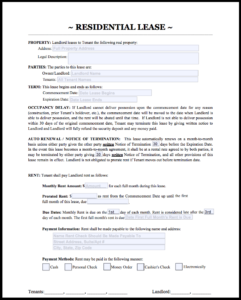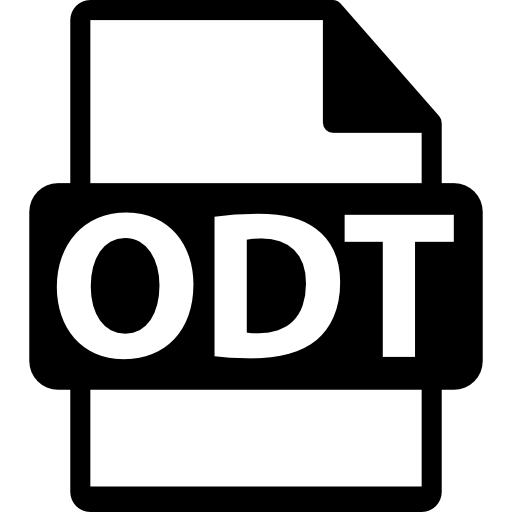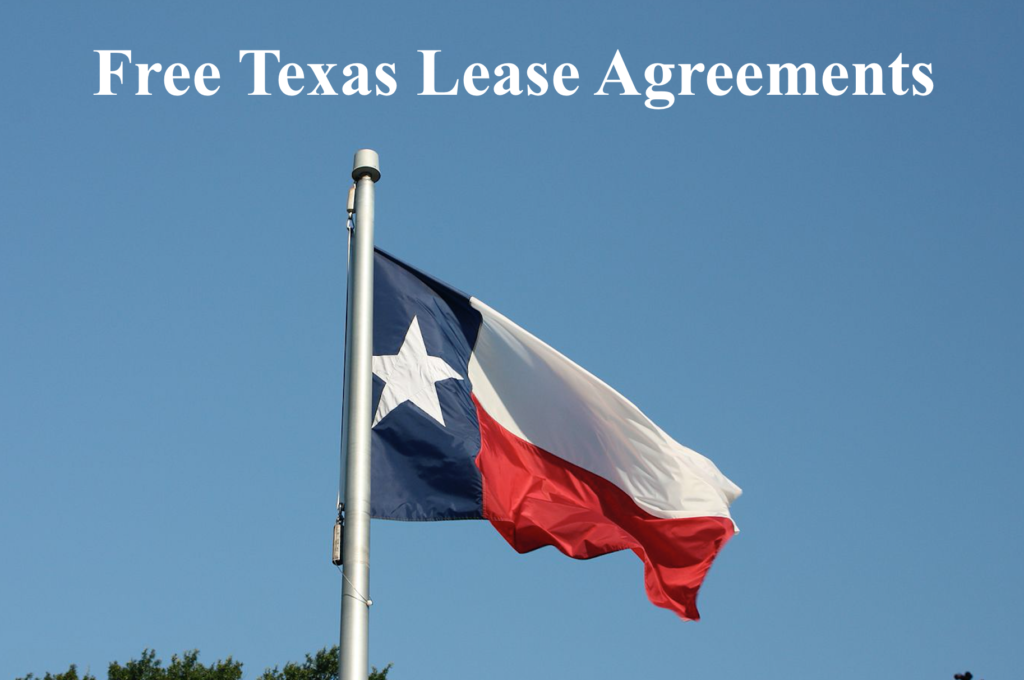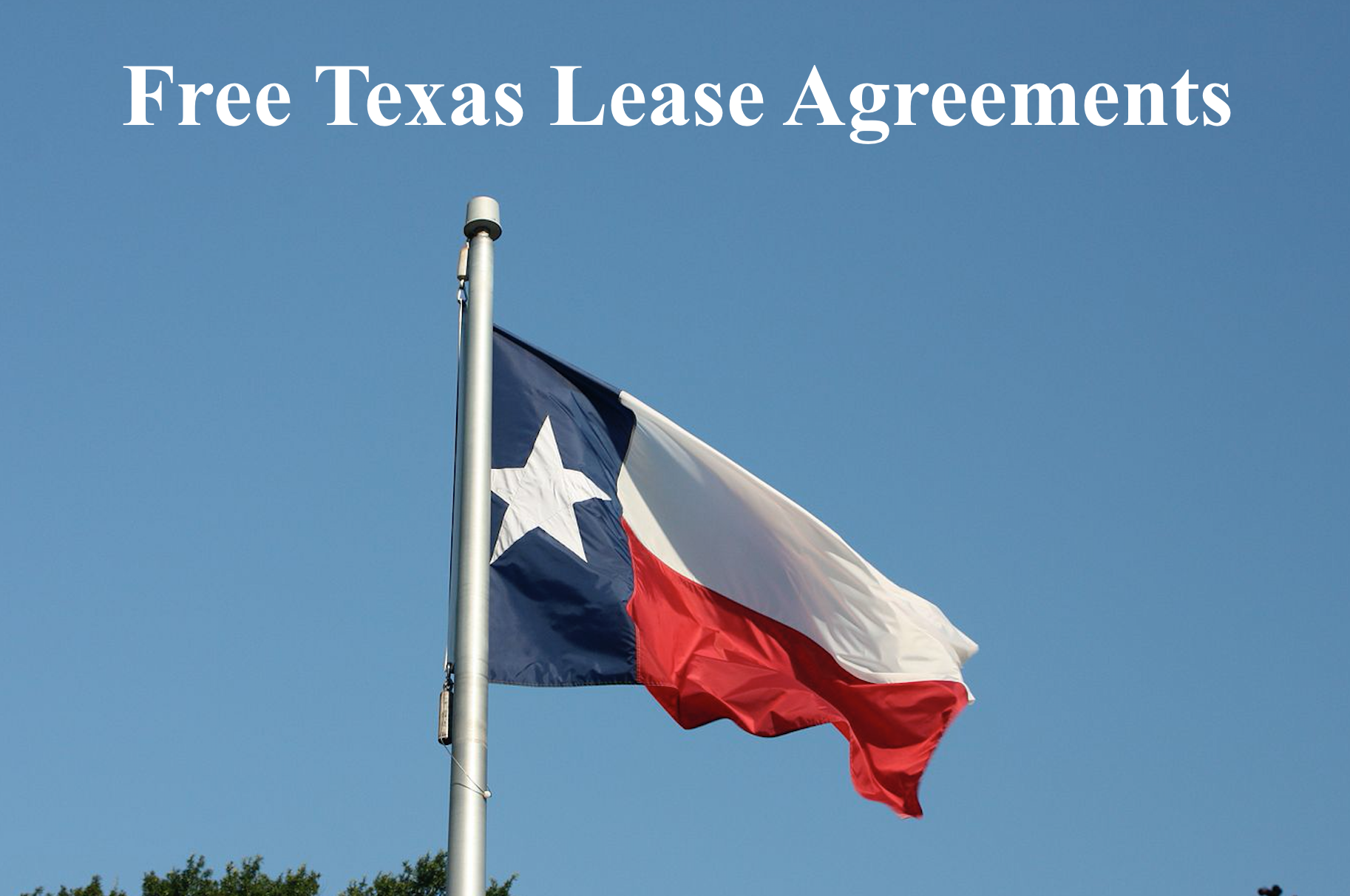Welcome to my post about Texas Residential Lease Agreements (Rental Agreements). In this post, I want to:
- Provide you with some FREE Texas Rental Agreements to download in PDF form and Word
- Explain to you the key sections of a Residential Lease in Texas, and how to fill them out
- Tell you the basic timelines and deadlines for Rental Agreements in Texas
- Explain to you my recommended signing process for signing leases with tenants
Also, at the end of this article is an earlier version of this blog post. I re-wrote it to make it more concise and easy to read. Let’s face it, writing about Texas Lease agreements is not the most entertaining thing to write about! But if you like building wealth as a landlord in Texas, you need to understand them! So let’s do it!
Free Texas Lease Agreements (Texas Residential Rental Agreements)

1. Free Texas Rental Agreement from eForms (Click Here)
2. Free Standard Lease Agreements from Landlord Guidance (our site):
![]()

3. Free TX Rental Agreement from Lone Star College (Click Here)
Key Sections of a Residential Lease in Texas
1. Property – Address and Legal Description
This section is obviously important as it identifies what property the tenant will be renting. Put the physical address (as known by the post office) and don’t forget the Unit Number if there is one. Then it is recommended to also put the Legal Description of the property. You can usually find this by looking at the local appraisal district website. The Legal Description usually includes the County, City, Subdivision Name, and Lot Number.
2. Parties – Names of Landlord and Tenants
The Landlord is the owner of the property, so either you as an individual, or your Company or LLC that owns the rental property. Make sure you do this accurately. For the Tenants, these are the renters who will live in your property and pay rent. Make sure to include the names of the Tenants on the lease, not just one.
3. Term – Start Date and End Date
The “Term” is the time period that the Tenants will rent your property under this lease. Typically it is for 12 months, however this is negotiable. Put in the start date and end date. Keep in mind that if neither party gives “Notice of Termination” then the lease will turn into a month-to-month at the same rental rate that is in the lease.
4. Rent – How Much and When
Finally the good part! The “Rent” is the amount of money the Tenant will pay the Landlord each month. If the Tenant is moving in during the middle of the month, you can put a “Prorated Rent” amount in the lease. This is the amount to cover a partial month. I recommend that before a Tenant moves in, they pay the Security Deposit (see below), the Prorated Rent, and the First Month’s Rent. The Rent section of the Texas Lease Agreement should also say where the Tenant can mail the rent, and what payment methods the Landlord accepts.
5. Security Deposit – How Much
The purpose of the Security Deposit is to protect the Landlord from Damage to the property. Normal “wear and tear” does not count. But if there are holes in the wall or other major damage, the Landlord will deduct this from the Security Deposit to cover that damage. For a Residential Rental Agreement in Texas, put into the lease the Amount you will collect as the Security Deposit. Typically it will be equal to one month’s rent, but it can be any amount. Texas Law does not regulate the Security Deposit Amount.
6. Pets – Allowed or Not and Pet Deposit
The “Pets” section is where you will select whether or not you will allow the Tenants to have a pet or pets. If you will allow pets, then this section is where you say what kind of pets are allowed and what kind of pets are not allowed. You should definitely cap the number of pets a Tenant can have so your property doesn’t get destroyed. You should probably also ban dangerous dog breeds and wild animals. This section also allows you to charge a Pet-Deposit, which is highly recommended. In fact, most Landlords charge a “non-refundable” pet deposit, because it is understood that pets will cause some kind of damage or bad smells, etc. in one way or another.
7. Special Provisions – Add Things in Plain Language
This is where you get to add anything that is not covered in the boilerplate language in the lease. Maybe there is some unique feature to the property that the tenant needs to maintain. You should also put in language about having “zero-tolerance” for late rent payments. Even though this has no legal significance, it lets the Tenant know that you are serious about getting your rent on time. If you’re using the Free Texas Rental Agreement Template available on this page, you’ll find the Special Provisions section toward the end of the lease.
8. Notices – Contact Info for Landlord and Tenant
This is the address where the landlord can be sent legal notices. You can also provide phone and email, but for legal situations, it is still the good old physical address that is used. There must also be an address put in where the Tenant can receive legal notices. This is almost always the address of the property being rented, but sometimes the Tenant might have a PO Box or a Guardian who manages their finances.
9. Signatures – Make it Official
The Landlord needs to sign and print their name (or name of the company), and the Tenants need to all sign their names. It is important to have all the adults living the property sign the lease. Why? Because if you need to evict, you will need to evict everyone who is in the property, not just one of the people in there.
Key Timelines and Deadlines for Texas Rental Lease Agreement, Security Deposits, and Eviction Notices
1. Security Deposit Amount and Deadline in Texas
- No limit on how much the Landlord takes as the Security Deposit in Texas
- Deposit Must be returned to Tenant within 30 days after Tenant moves out. Must include a letter with itemized deductions if Landlord does not return the entire deposit in full. To fully understand Security Deposits in Texas, it is important that you read Texas Property Code Annotated, Sections 92.101 to 92.109.
2. Texas Eviction Notice Time
- 3 Day Notice to Vacate (Eviction Notice) if Tenant fails to pay the rent or violates the lease. See Applicable TX Statute Here.
- 30 Day Notice to Move to end a Month to Month Tenancy. See TX Property Code Section Here.
How to Sign a Texas Residential Rental Agreement – Best Practices
Everyone loves Docusign PDF and all the other fancy electronic forms for e-signing stuff. It seems so easy – you just email your new tenants and they will electronically sign the lease. But there is a problem with this.
My current property management company still makes new tenants come to their office and sit down for a “signing ceremony.” Why?
You need to ask yourself what needs to be accomplished when you sign the lease. It is not just to get ink onto paper. The real reason (if you’re a successful landlord) is to set up the relationship with the tenants on your terms.
So print the lease (you can print from PDF, WORD, or ODT versions of the free Leases on this page) and meet with the future renter (tenant) in person.
If you meet with the tenant in person to sign, you can accomplish the following:
- Show the tenant that you are a serious business person
- Go over the rules for living in your house
- Let them know up front that you are strict when it comes to paying rent on time
- Makes them realize they are dealing with a real person
Of these 4 reasons to meet in person, telling them that you are strict with rent is the most important. Here’s why. At the end of the month, when they are short on paying the bills (like most people), their brain will say, “who can I pay late?” You don’t want them thinking that their soft, forgiving landlord will not mind getting paid late. In fact, you want them thinking that they MUST pay their rent first, before their Netflix bill.
I recommend saying something like this, “I’m a good landlord, I’m very responsive when there are problems, but I have a Zero Tolerance policy for late rent. Therefore it’s nothing personal, but my policy is that eviction notices go out on the 4th day of the month if rent is not received by then.”
Then, flip through the lease with them, and have them initial each page, and each section that is important to you. Most leases have a “Special Provisions” section where you can type what you want. I usually type into this section that I have a “zero-tolerance” policy for late rent” and I make them initial it. This may not have any legal significance, but psychologically it tells them that their landlord must be paid on time.
Then of course sign the lease on the last page.
If you are collecting the deposit and first months rent at that time, make sure it is a certified check or cash. I used to accept personal checks for this until I got burned. Tenants actually moved into my house, and I had received zero dinero because each of their $1500 checks bounced! Not good! When they pay you, be sure to give them a Rent Receipt.
As for giving them a copy of the signed lease, you can let them take pictures of it with their smartphone. Or you can take it back with you, scan it as a PDF, and then email it to them.
I can promise you that after going through this in-person signing process as opposed to emailing them an impersonal link, you have greatly increased your chances of getting the rent on time every month!
Texas Statutes and Court Cases Affecting Texas Landlord Tenant Residential Leases
Statutes (laws passed by the Texas Legislature)
Most Important: The Texas Property Code. Simply taking the time to read it will give you a very good understanding of the laws around Residential Leases in Texas.
Caselaw (Cases decided by judges)
For a great read involving urine encrusted toilets and nauseating smells caused by bad tenants who think they still get their Security Deposit back, check out the Dallas, Texas case of PULLEY v. MILBERGER
Texas Rental Agreement Laws Article – Older Version:
Whenever you rent a home or apartment in Texas, you will want a residential lease agreement that is inclusive of state law requirements for your tenant to review and sign. Although oral leases are valid, you take the risk of your tenant misconstruing certain terms that could lead to litigation.
A properly drafted lease agreement provide protections for you as well as your tenant by enumerating the terms under which security deposits and rent are to be paid as well as other duties and obligations of both parties.
Common Sections in a Texas Residential Rental Lease Agreement
- Names of the renters and landlord
- Amount of security deposit
- Rent to be made by a certain date each month
- Manner in which rent is to be paid and to whom
- Description and address of the property
- Length of the lease
- If pets are allowed and if so, which ones and their size
- Whether the property may be subleased
There are laws governing the content of leases and prohibitions on a property owner’s decision on whom to rent. Anti-discrimination laws forbid property owners for refusing to rent to someone on the basis of sex, religion, color, sex, national origin or familial status. For other matters, Texas landlords have considerable discretion.
Security Deposits in Texas
A security deposit is to ensure that whatever damage is done to the unit or rental property is paid for out of these funds. The damage cannot be due to normal wear and tear but from the negligence of the tenant. Wear and tear is defined as deterioration from the intended use of the dwelling including breakage or malfunction from age or deterioration so long as it was not from the carelessness, accident or abuse of the premises by the tenant or any guest of the tenant.
As a Texas residential landlord, you are free to charge whatever the market will bear or whatever you wish. There is no Texas state law limiting it like other states and the interest on the deposit can be at the rate offered by whichever account in which it is deposited in. In fact, there is no requirement that a security deposit be in any specific account. A landlord’s discretion also applies to deposits for pets or any other condition that the landlord may require that is in addition to the general security deposit.
Once the tenant moves out, you must return the entire security deposit, including any interest earned on it, within 30 days after the property is vacated. If you find damage in the unit that is not attributable to wear and tear, you are required to submit to your former tenant a written description of the damage and the charges to be incurred.
Rent and Fees Charged in Texas Leases
A Texas landlord can increase the rent at any time. You should include a late fee provision in the agreement but there is no limit on what you may charge nor is there a limit on what you may charge if a rent check is returned for insufficient funds.
Obligations of the Landlord
Landlords have an obligation to provide a dwelling that is habitable, which includes basic amenities like water, heating, electricity and plumbing. Should something malfunction and the tenant notifies the landlord but for some reason, the landlord ignores or refuses to fix the problem, the tenant is probably allowed to withhold rent, although there is no governing statute. However, the law does obligate the landlord to provide these basic utilities and to remedy any condition materially affecting the health or safety of the tenant. A court can order a landlord to repair any such hazardous condition.
Landlords should know that there is no self-eviction law whereby a landlord can force a tenant to vacate, because of nonpayment of rent or any other material violation of the lease, by shutting off utilities or locking out the tenant absent a court order or order of eviction.
Texas Rental Lease Agreement Termination
Regarding termination, the landlord must give one-month notice for either a month-to-month lease or for a yearly one. The tenant and landlord can negotiate for a longer period for a month-to-month.
If the tenant has not paid rent, the landlord may issue a 3-Day Notice to Vacate to the tenant; after this time, the landlord can file for eviction. There is no prior notice obligation to the tenant if the landlord wishes to terminate the lease for any other violation of the lease so that the landlord may file for eviction at any time he/she feels a provision or lease term was violated that gives rise to termination.
A landlord does have the right to immediately terminate a lease if the tenant violates any part of Chapter 43 of the Texas Penal Code relating to public decency. This applies to any act of prostitution or conduct pertaining to child pornography or obscenity.
As stated above, the tenant can elect to terminate the lease without further obligation if a condition exists that is a danger to the health or safety of an ordinary tenant and the landlord fails to remedy it after having been given notice.
Entry of Premises
A landlord may not enter the leased premises at will but must give prior notice, though no minimum notice period is stated by law. The entry time should at least be reasonable, although the landlord may enter in an emergency situation without notice or if the tenant has been vacant from the premises for an extended period of time.
Required Disclosures
Texas law requires certain terms or provisions to be included in a residential lease agreement:
- Name and address of property owner
- Name and address of property manager, if any
- Right to remove deceased tenant’s property from abandoned premises 30 days after providing certified notice to a person or address known as stated point-of-contact and no claim to the property has been made
- If subletting is permitted
- Require the tenant to provide proof of domestic violence if a tenant seeks release from a lease
- That a tenant may break a lease if a victim of domestic violence, sexual assault or sexual abuse
- That the tenant has a right to repair and deduct rent (no more than one-month’s rent or $500) or vacate the premises with no further obligation if the landlord fails to remedy a condition that directly affects the health or safety of an ordinary tenant.
However, a justice of the peace is authorized to order a property owner to repair or remedy a hazardous condition that affects a tenant’s health and safety so long as the repair does not exceed $10,000. The tenant can go to court without an attorney to obtain the repair order.
Landlords are required to provide smoke detectors and may not waive this in a lease. There are safety devices that must be installed such as keyed dead bolts on exterior doors, sliding door security bars, window latches and door viewers.
Also, each Texas county or municipality may have its own ordinances pertaining to any of the disclosures or rights and obligations of either party. Consult with a landlord/tenant attorney if you have any questions or issues regarding Texas residential lease agreements.
Lease Agreements by States
Choose the state where your rental property is located:


You must be logged in to post a comment.